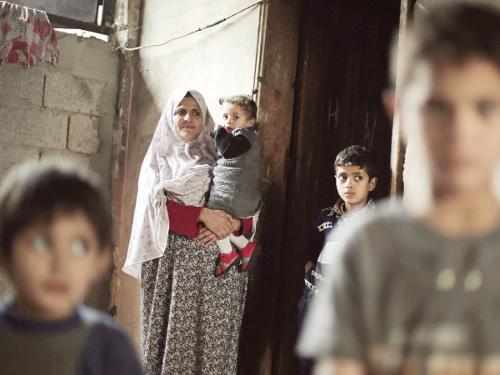AFTER MOMENT OF FEAR, WOUNDED GAZA GIRL GOES HOME


Gaza, 14 Rabi’ul Akhir 1436/4 February 2015 (MINA) – Screaming, covered in red burns and welts from shrapnel, 13-month-old Anwar Saad’s fear and pain showed across her face as five pairs of white-gloved hands gently brought her down on an examination table.
The moment of chaos, one of many at Gaza City’s Shifa Hospital during last summer’s war between Israel and Hamas, became an image shared worldwide after Associated Press photographer Khalil Hamra captured it.
Now, some six months later, Anwar is back at her home in the Gaza Strip. But her family’s suffering has not abated, Saudi Gazette quoted by Mi’raj Islamic News Agency (MINA) as reporting.
The summer’s Gaza blitzkrieg, the third by Israel since Hamas seized the seaside territory, killed more than 2,200 Palestinians and 72 people on the Israeli side. At least 1,483 Palestinian civilians were killed in the war — 66 percent of the overall death toll — according to preliminary United Nations figures.
For the Saads, the war came into their home on July 18, when they say an Israeli tank shell crashed through the wall of their house in Gaza’s crowded Shijaiyeh neighborhood. Shrapnel wounded all of the Saad family, most seriously Anwar, her mother, Abeer Saad, and her 3-year-old brother, Mahmoud Saad.
Anwar’s father, Mohammed Saad, rushed his wounded family to Shifa Hospital. “I did not know where to go,” he later recalled. “Shall I go to see my wife at the women’s surgery department or go to the men’s surgery where my older son is staying, or to the children’s surgery department to see Anwar and Mahmoud?“
Hamra, on hand at the hospital to cover the work of doctors treating the wounded, saw Anwar and followed her into an examination room. He shot his photograph overtop the infant against the black exam table, the bright overhead lights drawing deep shadow into the rest of his image.
Today, Anwar has returned to her family’s damaged one-story home. Their living room serves as a sleeping and cooking area now, because the damaged kitchen and adjacent bedroom are still unusable. The roof of the living room is charred and the smell of smoke still lingers.
Anwar’s father built new walls for the kitchen and the bedroom, but stopped rebuilding because he ran out of money. He said he quit his job in a coal workshop because the war drove up his blood pressure.
And Anwar’s mother spends much of her time caring for her daughter. The toddler only stops crying when she is in her rocking bed.
Before the war, Anwar was playful and alert, the mother said. Not any longer.
“Now she doesn’t play with her siblings. She is always dull and every now and then we take her to the doctor,” she said. “I wish she would go back to how she was in the past.”
Here are a series of AP photographs shot by Hamra of Anwar at the time of her being wounded and how she lives now. (T/P010/P3)
Mi’raj Islamic News Agency (MINA)



